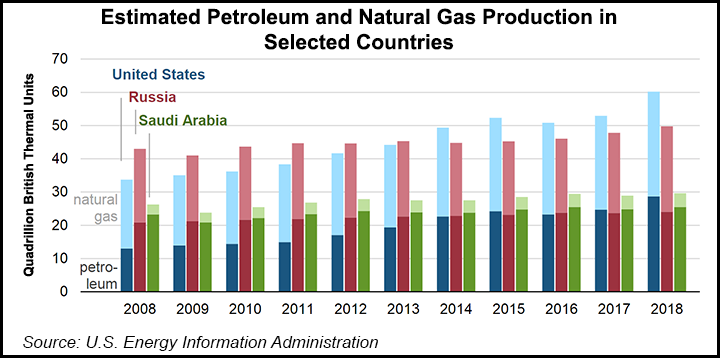E&P | NGI All News Access | NGI The Weekly Gas Market Report
U.S. Set Combined Natural Gas, Oil Production Record in 2018
The United States established a new production record for natural gas and petroleum last year, simultaneously extending a decade-old lead on Russian gas production volumes and surpassing Saudi Arabia to become the world’s largest producer of petroleum, according to the U.S. Energy Information Administration (EIA).

Domestic natural gas production in 2018 increased 12% compared with the previous year, while petroleum production rose by 16%, according to the agency.
“Last year’s increase in the United States was one of the largest absolute petroleum and natural gas production increases from a single country in history,” EIA said.
Since 2009 the United States has been the world’s largest natural gas producer, exceeding Russia, and it has been the leading petroleum producer since 2013, when output exceeded Saudi Arabia.
The United States produced 28.7 quadrillion Btu of petroleum in 2018, which was composed of 80% crude oil and condensate and 20% natural gas plant liquids. U.S. crude oil production was nearly 11 million b/d in 2018, a 17% increase from 2017, with Texas/New Mexico’s Permian Basin accounting for most of the increase.
U.S. dry natural gas production in 2018 was 28.5 Bcf/d, reaching a record high for a second consecutive year.
Russia’s oil and gas production also reached record levels in 2018, while Saudi Arabia’s annual average oil production increased slightly, but it remained lower than in 2016, when Saudi oil output reached a record high. Saudi oil production reached an all-time monthly high last November, before an agreement by the Organization of the Petroleum Exporting Countries to extend production cuts.
Production from both the United States and Russia is almost evenly split between natural gas and oil, while Saudi production heavily favors petroleum, EIA said.
EIA’s analysis dovetailed neatly with a benchmark report released by BP plc in June. BP economists determined that global energy demand overall in 2018 increased by 2.9% year/year, while global liquefied natural gas (LNG) supply continued a rapid expansion, increasing by almost 10% as new liquefaction plants in Australia, the United States and Russia were either started or ramped up.
The United States is set to produce more oil and liquids than Russia and Saudi Arabia combined by 2025, according to an analysis by Rystad Energy. Over the next five years, the United States will account for about 70% of global oil growth and nearly 75% of LNG export expansions, according to a recent International Energy Agency analysis.
© 2024 Natural Gas Intelligence. All rights reserved.
ISSN © 1532-1231 | ISSN © 2577-9877 | ISSN © 1532-1266 |
